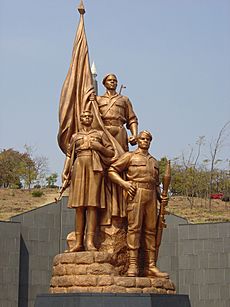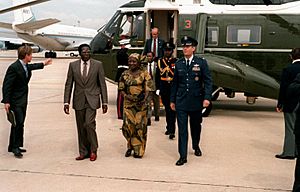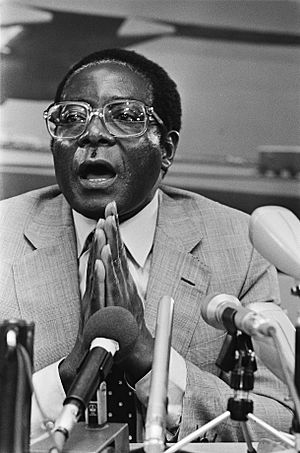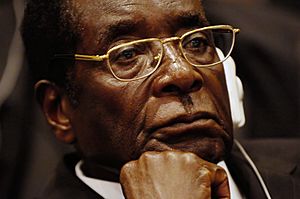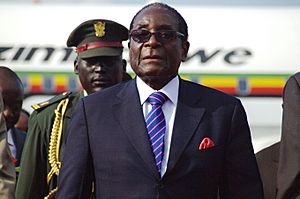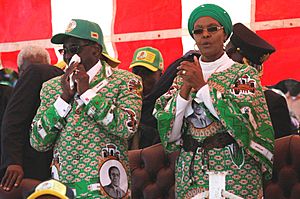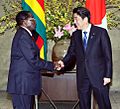Robert Mugabe facts for kids
Quick facts for kids
Robert Mugabe
|
|
|---|---|
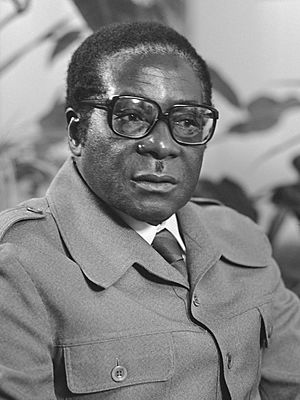
Mugabe in 1979
|
|
| 2nd President of Zimbabwe | |
| In office 31 December 1987 – 21 November 2017 |
|
| Prime Minister | Morgan Tsvangirai (2009–2013) |
| First Vice-president |
|
| Second Vice-president |
|
| Preceded by | Canaan Banana |
| Succeeded by | Emmerson Mnangagwa |
| 1st Prime Minister of Zimbabwe | |
| In office 18 April 1980 – 31 December 1987 |
|
| President | Canaan Banana |
| Deputy | Simon Muzenda |
| Preceded by | Abel Muzorewa (Zimbabwe Rhodesia) |
| Succeeded by | Morgan Tsvangirai (2009) |
| Leader and First Secretary of ZANU–PF ZANU (1975–1987) |
|
| In office 18 March 1975 – 19 November 2017 |
|
| Chairman |
|
| Second Secretary |
|
| Preceded by | Herbert Chitepo |
| Succeeded by | Emmerson Mnangagwa |
| 13th Chairperson of the African Union | |
| In office 30 January 2015 – 30 January 2016 |
|
| Leader | Nkosazana Dlamini-Zuma |
| Preceded by | Mohamed Ould Abdel Aziz |
| Succeeded by | Idriss Déby |
| 10th Secretary-General of the Non-Aligned Movement | |
| In office 6 September 1986 – 7 September 1989 |
|
| Preceded by | Zail Singh |
| Succeeded by | Janez Drnovšek |
| Personal details | |
| Born |
Robert Gabriel Mugabe
21 February 1924 Kutama, Southern Rhodesia (now Zimbabwe) |
| Died | 6 September 2019 (aged 95) Singapore |
| Resting place | Kutama, Zimbabwe |
| Political party | |
| Spouses | |
| Children | 4, including Bona and Robert Jr |
| Alma mater |
|
| Signature |  |
Robert Gabriel Mugabe (born February 21, 1924 – died September 6, 2019) was an important political leader in Zimbabwe. He served as the first Prime Minister of Zimbabwe from 1980 to 1987. After that, he became President from 1987 until 2017. Mugabe was a key figure in Zimbabwe's fight for independence from British rule. He was seen by many as a hero for helping to free the country. However, he also faced criticism for his leadership, economic problems, and issues with human rights.
Contents
Early Life and Education
Growing Up in Southern Rhodesia
Robert Gabriel Mugabe was born on February 21, 1924. His birthplace was the Kutama Mission village in what was then called Southern Rhodesia. This area is now known as Zimbabwe. His father, Gabriel Matibiri, worked as a carpenter. His mother, Bona, was a Christian teacher for children in the village. Robert was one of six children in his family.
Mugabe was a very good student. He was a quiet child who loved to read books. He preferred reading over playing sports or spending time with other children. Some children teased him, calling him a "mother's boy" and saying he was a coward.
Becoming a Teacher
After finishing six years of elementary school, Mugabe was offered a spot in a teacher training program. This was at Kutama College in 1941. His mother could not pay for the school, but his grandfather helped with some of the costs. As part of his training, Mugabe started teaching at his old school. He earned a small amount of money each month, which he used to help his family. He earned his teaching diploma and left Kutama in 1945.
Studying in South Africa and Ghana
In 1949, Mugabe received a scholarship to study at the University of Fort Hare. This university is located in South Africa. In 1952, he earned a Bachelor of Arts degree in history and English literature. He later said that his time at Fort Hare was a "turning point" in his life.
In 1958, Mugabe moved to Ghana to teach at St Mary's Teacher Training College. There, he met his first wife, Sally Hayfron. Ghana was the first African country to gain independence from European colonial powers. Mugabe was inspired by the changes happening there under its leader, Kwame Nkrumah. He said he went to Ghana to see what an independent African country was like. It was in Ghana that he became more interested in African nationalism. He joined those who wanted black majority rule in their own independent countries.
Fighting for Independence
Return to Southern Rhodesia and Imprisonment
In August 1963, Mugabe and Hayfron had a son named Nhamodzenyika. This Shona name means "suffering country." Mugabe decided to return to Southern Rhodesia.
At this time, there was growing tension and conflict in the country. Black Africans were upset with the white minority government. Mugabe believed this conflict was needed to end British colonial rule. After he spoke out against the government, he was accused of speaking against the government and was sent to prison for 21 months.
While Mugabe was in prison, the government arrested other African nationalist leaders in August 1964. In November 1965, the government declared its independence from the United Kingdom. It renamed Southern Rhodesia as Rhodesia. The UK did not agree with this and placed economic restrictions on the country. By 1972, African nationalists began an armed struggle against the government.
Leading the Fight for Freedom
After his release from prison, Mugabe went to Mozambique. He became a leader of the ZANU political party. He guided the party's role in the Rhodesian Bush War, fighting against the government led by Ian Smith. He later took part in peace talks in the United Kingdom. These talks led to the Lancaster House Agreement, which ended the war.
In the 1980 general election, Mugabe led his party, ZANU-PF, to victory. He became Prime Minister when the country, now called Zimbabwe, gained its full independence later that year.
Leading Zimbabwe
Prime Minister: Building a New Nation
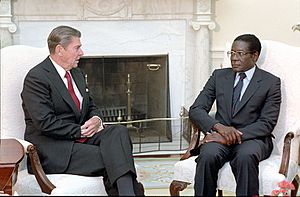
Once he became Prime Minister, Mugabe worked with architects from North Korea. They designed Heroes' Acre, a monument in Harare. It was built to remember those who fought against minority rule. Zimbabwe also received a lot of help from Western countries. These countries hoped that a stable Zimbabwe would help South Africa move away from its system of apartheid.
During Mugabe's time as Prime Minister, Zimbabwe's economy grew. However, the population grew even faster, so people's real income went down. Unemployment also increased. Despite this, Mugabe's government greatly increased spending on education and health. In 1980, Zimbabwe had only 177 secondary schools. By 2000, this number had grown to 1,548. The number of adults who could read and write went from 62% to 82%, which was one of the highest in Africa. Child immunization rates also went up significantly.
At independence, a large amount of Zimbabwe's land was owned by a small number of white farmers. Most black people lived on 'communal land' which was often crowded. The Lancaster House Agreement said that until 1990, land could only be bought if the owner wanted to sell it. The government could only buy land by force if it was not being used enough or was needed for public use. In these cases, they had to pay the owner fully. This meant Mugabe's government mostly bought land that was not very good. Their goal was to move 18,000 black families onto 2.5 million acres of white-owned land.
Mugabe first focused on bringing different groups together. He wanted to have a good relationship with white Zimbabweans. He hoped to stop white people from leaving the country. He tried to calm fears that he would take over white-owned property. Still, some white Zimbabweans felt they were treated unfairly.
President: Challenges and Changes
In late 1987, Zimbabwe's parliament changed the country's rules. On December 30, Mugabe became the executive president. This new role combined the jobs of head of state, head of government, and commander of the armed forces. It gave him the power to close parliament, declare special powers, and run for president as many times as he wanted.
During the 1990s, Zimbabwe's economy faced more problems. By 2000, living standards were lower than in 1980. People's average wages were less, and unemployment had tripled. By 1998, almost half the country's workers were unemployed. Many skilled workers left Zimbabwe.
In 1997, people who had fought in the war for independence demanded pensions. In August 1997, Mugabe created a pension plan that would cost a lot of money. To pay for this, his government suggested new taxes. But a general strike happened in December 1997 to protest these taxes. Mugabe's government then dropped the new taxes. In January 1998, protests about not having enough food broke out in Harare. The army was sent in to restore order, and some people were killed or injured.
Mugabe increasingly blamed the country's economic problems on Western nations and the white Zimbabwean minority. This group still controlled most of the country's farms, mines, and factories. He encouraged his supporters to "strike fear in the hearts of the white man, our real enemy."
Land Reform and Economic Issues
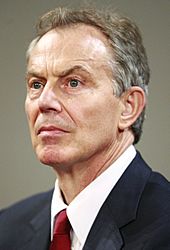
In 1997, Tony Blair became the Prime Minister of the UK. His government was hesitant to restart payments for land resettlement. These payments had been promised in the Lancaster House Agreement. In October 1999, Mugabe visited Britain. An activist tried to arrest him there. This made relations between Britain and Zimbabwe worse. In May 2000, the UK stopped all development aid to Zimbabwe. In December 1999, the IMF also stopped financial support for Zimbabwe. They said it was because of economic problems and corruption.
In February 2000, groups of people began to take over white-owned farms. The government called these groups "war veterans," but most were young, unemployed people. Mugabe said these actions were fair because white settlers had taken the land from the local African people in the 1890s. He presented the takeovers as a fight against colonialism. He also claimed that the UK was trying to remove his government. In May 2000, he issued a rule that allowed the government to take farms without paying for them. He insisted that the British government should make these payments.
In November 2001, Mugabe issued another rule. This allowed the government to take almost all white-owned farms in Zimbabwe without paying for them. Mugabe's actions were strongly criticized by many.
In December 2014, Mugabe removed his vice-president, Joice Mujuru. He accused her of trying to remove him from power. In January 2015, Mugabe was chosen as the Chairperson of the African Union (AU). In November 2015, he said he planned to run for president again in 2018, even though he would be 94 years old. His party, ZANU–PF, accepted him as their candidate. In February 2016, Mugabe stated he would not retire and would stay in power "until God says 'come'."
End of His Leadership
Military Intervention and Resignation
On November 15, 2017, the Zimbabwe National Army placed Mugabe under house arrest at his home. They said they were taking action against "criminals" around Mugabe.
On November 19, he was removed as leader of ZANU–PF. Emmerson Mnangagwa was appointed in his place. The party also gave Mugabe a deadline: resign by noon the next day, or they would try to remove him from office. Before resigning, Mugabe and his wife made a deal. This deal meant he and his family would not be charged with crimes. His business interests would remain untouched, and he would receive a payment of at least $10 million.
Life After Presidency
In late December 2017, a government announcement stated that Mugabe was given full diplomatic status. This meant he had special protections. He also received a large house, up to 23 staff members, and personal vehicles, all paid for by public funds. He was allowed to keep his business interests and other wealth he had gained while in power. He also received an additional payment of about ten million dollars.
On March 15, 2018, Mugabe gave his first interview since being removed from the presidency. He insisted that he had been removed by a "military takeover" that needed to be undone. He said he would not work with Mnangagwa and called Mnangagwa's presidency "not right" and "not allowed by the rules."
Later Years and Passing
In November 2018, Emmerson Mnangagwa said that Mugabe was unable to walk. He had been receiving medical treatment in Singapore for two months. He was hospitalized there again in April 2019. This was one of several trips he made to Singapore for medical care, both during and after his presidency. He passed away at Gleneagles Hospital in Singapore on September 6, 2019, at about 10:40 AM. He was 95 years old. He was given a state funeral.
Mugabe was buried in his hometown of Kutama. The burial took place on September 28 in a courtyard at his family home.
Images for kids
-
Morgan Tsvangirai led the MDC, a party that became more successful in opposing Mugabe's government.
-
Mugabe was inspired by the example set by Ghana's Kwame Nkrumah.
-
While Mugabe was imprisoned, Ian Smith became leader of Rhodesia.
-
Mugabe meeting Romanian communist leader Nicolae Ceaușescu in 1976.
-
Mugabe meeting Japanese prime minister Shinzo Abe in 2016.
-
Mugabe meeting Russian president Vladimir Putin in 2015.
-
Mugabe's first wife, Sally Hayfron, in 1983.
See also
 In Spanish: Robert Mugabe para niños
In Spanish: Robert Mugabe para niños


